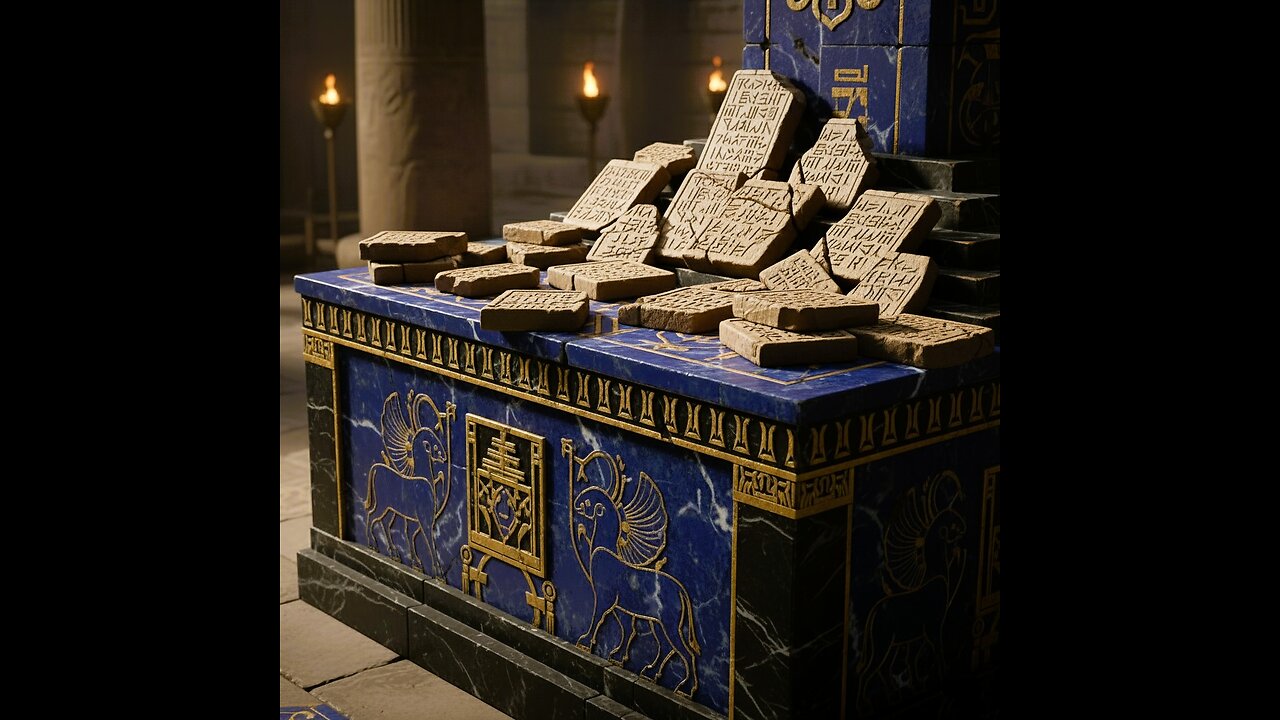Premium Only Content

The Eridu Genesis: The Oldest Creation and Flood Narrative on Record
Before there was a beginning, there was Nammu, who embodied the chaotic, formless void from which all creation emerged. She was the primordial sea and original mother, the cosmic womb that birthed An, the sky, and Ki, the earth, thus initiating the order of the cosmos. From their union came the next generation of gods.
This is the saga of the Eridu Genesis, humanity’s oldest known creation and flood narrative. Etched on fragmented cuneiform tablets unearthed at Nippur, it offers profound insight into early Mesopotamian thought, where divinity, kingship, and creation intertwined.
An, father of the gods, personifies the heavens and reigns over the upper cosmos. Dwelling in distant serenity, he rarely interferes in mortal affairs, sustaining harmony by delegating power to his son Enlil. Though distant, An’s presence represents the framework of divine order.
Ki, the earth goddess, embodies fertility, agriculture, and the living ground itself. Together, An and Ki symbolize the eternal bond between heaven and earth, the marriage of sky and soil that brings forth life.
Enlil, god of wind, air, and storms, holds dominion over nature’s balance. He separated heaven and earth, establishing cosmic structure and granting kingship to mortals as divine mandate. Rulers invoked his name to legitimize their power. Yet Enlil’s nature is double-edged: he nourishes and destroys, blessing fields with rain or unleashing floods in fury. In the flood narrative, he condemns humankind for its transgressions, commanding the deluge meant to cleanse the world. His temple, Ekur, stood at Nippur as the sacred center of divine authority.
In contrast, Enki (Ea), god of water, wisdom, and creation, is humanity’s benefactor. Acting under Nammu’s guidance, he shaped humans from clay and taught them agriculture, laws, and crafts. When Enlil decreed the flood, Enki defied him by warning Ziusudra, king of Shuruppak, to build a vessel and preserve life. After the flood subsided, Ziusudra’s boat came to rest on a mountaintop; the gods granted him immortality, ensuring humanity’s survival. Enki’s temple, Abzu, at Eridu, honored his role as the divine patron of life and knowledge.
Inanna, the radiant Queen of Heaven, embodies love, fertility, and war. Her passions reflect the full range of human emotion, love and lust, ambition and vengeance. Her Descent to the Underworld mirrors the cycles of life, death, and rebirth. The Eanna temple at Uruk was devoted to her, celebrating both her nurturing and warrior aspects.
Her sister Ereshkigal, queen of the underworld, rules over the realm of the dead. All souls, noble or humble, pass into her shadowed domain. She enforces the laws of death with unyielding authority, ensuring cosmic balance. When Inanna tried to enter the underworld without respect, Ereshkigal punished her, reminding mortals of death’s inevitability. Her temple at Kutha reflected her solemn importance in Mesopotamian belief.
The Eridu Genesis shares striking parallels with later myths, the Epic of Gilgamesh, the Enuma Elish, and the biblical story of Noah. Each preserves memories of floods, divine wrath, and renewal, revealing humanity’s enduring fascination with creation, destruction, and survival.
Through these myths, early civilizations sought to understand the forces governing their world, why floods came, why kings ruled, and why life ended in death. The gods of Sumer personified nature’s elements and reflected the fragile balance between chaos and order.
From Nammu’s formless sea to the flood that reshaped the world, the Eridu Genesis reveals the first great human attempt to find meaning in existence. It portrays creation not as random chance, but as sacred design, woven by gods who mirrored the cycles of nature and the struggles of humanity itself.
Since the dawn of civilization in the Fertile Crescent, reverence for nature and its divine embodiment has shaped human culture. Whether through myth, temple, or art, the people of ancient Mesopotamia laid the foundation for the spiritual traditions that followed. Their stories remain a testament to humanity’s timeless desire to understand creation, the divine, and our place within the cosmos.
-
 4:43:07
4:43:07
Grant Cardone
7 hours agoGrant Cardone EXPOSES How the 1% REALLY Build Wealth (LIVE)
198K8 -
 1:19:20
1:19:20
Jeff Ahern
4 hours ago $9.75 earnedThe Saturday Show with Jeff Ahern
19.2K7 -
 LIVE
LIVE
GritsGG
7 hours agoQuads Win Streak! Top 70! Most Wins in WORLD! 3744+!
112 watching -
 13:26
13:26
Cash Jordan
1 day ago“PORTLAND MOB” Storms ICE HQ… ‘COMBAT’ Troops Respond With EXTREME FORCE
67.3K195 -
 4:32:52
4:32:52
ttvglamourx
6 hours ago $2.09 earnedFINSIHING YEAR 1 ON STARDEW !DISCORD
12.9K -
 3:49:46
3:49:46
Tommy's Podcast
5 hours agoE828: Vortex
11.8K -
 4:51:46
4:51:46
BubbaSZN
6 hours ago🔴 LIVE - BEATING DL: THE BEAST & MAYBE SOME SIDE STUFF
11.2K -
 DVR
DVR
Major League Fishing
9 days agoLIVE! - Fishing Clash Team Series: Patriot Cup - Day 4
51.6K -
 1:31:04
1:31:04
Rebel News
1 day agoTommy Robinson & Avi Yemini Banned from Al-Aqsa mosque!
12.2K31 -
 2:18:29
2:18:29
XxXAztecwarrior
3 hours agoPrinting money on Delta
5.71K